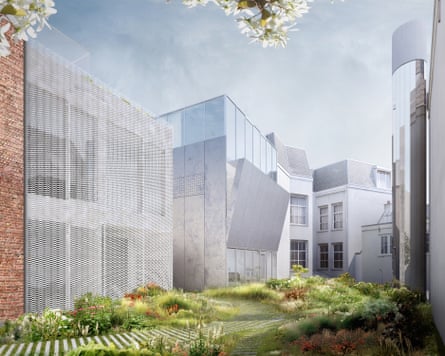Amsterdam was once famous for its alternative nightlife but now a planned new multi-storey building that will be home to a club, cafe and apartments has become a flashpoint in the battle between preserving heritage buildings and rowdy entertainment.
In the latest urban planning tussle to hit one of Europe’s most densely populated countries, neighbours of Amsterdam’s planned “Institute for Night Culture” (INC) fear it will shake their foundations.
Last week the Netherlands’ highest administrative court, the Council of State, granted planning permission for the project despite residents’ concerns about lost sunlight, increased bike traffic and potential damage to historic structures.
When the INC, a non-profit initiative, was announced last October, the architect David Mulder van der Vegt said it would be “this hidden place, this underworld where all kinds of people … will meet”. The city gave it a €50,000 subsidy and the deputy mayor Touria Meliani said it would be an experimental antidote to a growing “monoculture” in the city’s nightlife.
But, reflecting tensions that are rife in city planning as the Netherlands aims to build almost a million houses by 2030 and decide whether to build more layers in cities, the plans were far from unanimously welcomed.
Walther Schoonenberg, an architecture historian and secretary of the Friends of Amsterdam City Centre (VVAB), said the project, which envisages deep cellar construction, could threaten structural integrity, when one in 10 Dutch houses already face subsidence.
“Very little is known about the state of the foundations and every time digging starts, it turns out they are in poor condition,” he said. “There are a number of risks, but the Council of State has set them aside.”
Others, however, believe extensive Dutch planning procedures are slowing down vital development. “These sorts of legal cases take years,” said Madeline Buijs, the head of research at Colliers, a real estate advice firm. “And of course that means delays to new housing.”
Such delays have a financial cost too, economists say. When developers have to factor in time for appeals, this in effect becomes a “tax on development”, said Matthijs Korevaar, of Erasmus University Rotterdam. “Dutch cities are well planned, and part of that is the long and careful procedure to be able to build,” he said. “Trading off the benefits for insiders versus outsiders is always political.”
Historic housing had not always been protected, he said: the Halvemaansteeg, or “half moon alley”, on which the new nightlife centre is to be built would have been turned into a canal in the 17th century if the city had not balked at the cost.
As populations expand, urban residents may have to accept taller cities where views and sunlight are not protected, according to Cees-Jan Pen, a professor studying urban development at the Fontys University of Applied Sciences in Eindhoven. “Everyone wants to solve the housing crisis – just not in front of their own door,” he said. “But we need to build a little higher, a couple of extra layers. And building in existing cities is more sustainable, too.”
A spokesperson for the INC, which is due to open in 2028, said the risks should be minimal. “The construction method for the basement has also been successfully used in recent years in other projects in the historic centre of Amsterdam,” he said. “External experts have confirmed in a second opinion that with the proposed construction method, potential risks can be managed well.”









